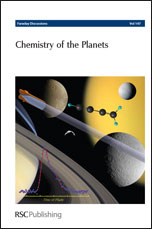Chemical origins of the Mars ultraviolet dayglow
Abstract
Airglow optical emissions from planetary atmospheres provide remotely observable signatures of atmospheric composition, energy deposition processes, and the resulting chemical reactions. We may one day be able to detect airglow emissions from extrasolar planets. Reliable interpretation requires quantitative understanding of the energy sources and chemical mechanisms that produce them. The ultraviolet dayglow observations by the Mariner 6 and 7 (1969) and Mariner 9 (1971–72) motivated numerous modeling studies and laboratory experiments. The most obvious source reaction is photodissociation and photoionization of ambient CO2, which is known in the laboratory to produce the four strong dayglow emitting states:
- This article is part of the themed collection: Chemistry of the Planets

 Please wait while we load your content...
Please wait while we load your content...